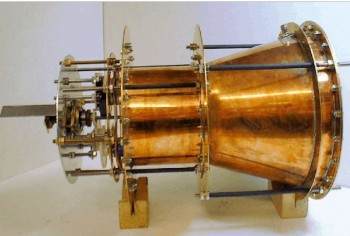Part One of Two Parts
I have written a number of posts about propulsion systems for spacecraft. There are many different existing and proposed systems utilizing different sources of energy and propellant. However, all of these systems share several properties. First, they all obey the known laws of physics. Second, they all have to throw something referred to as propellant out the back of the engine to move it forward. However, there is a new engine being tested that appears to violate these two properties. So far, the new engine has been tested in laboratories and does seem to generate thrust. I have been reluctant to discuss this new engine because it appears to violate the laws of physics. There is no agreed upon theory of how it operates. A version of the engine will soon be tested in space.
The force generated by rocket engines can be measured in what are called newtons named for Isaac Newton. "One newton is the force needed to accelerate one kilogram of mass at the rate of one meter per second squared in direction of the applied force." (Wikipedia) The chemical rockets engines that powered the Saturn V rockets for the Apollo missions generated tens of millions of newtons. The most efficient plasma engines called Hall thrusters which use electric charge to expel ions for thrust can generate about sixty millinewtons or sixty-thousandths of a newton.
Microwaves are electromagnetic waves with a frequency range from three hundred megahertz to three hundred gigahertz and wavelengths between one millimeter and one meter. Because these wavelengths are the scale of objects in the human world, it is possible to control microwaves with physical constructs at the human scale. Metal tubes called waveguides can be used to channel microwaves and chambers called cavity resonators can be used to contain them.
In 2001, Roger Shawyer created Satellite Propulsion Research. His new company was established with a grant from a U.K. government program to develop his electromagnetic or "EM" drive. The new engine is a truncated metal cone roughly the size of a loaf of bread sealed at both ends which functions as a cavity resonator. Picture a traffic cone with the top half cut off. It is powered by a microwave generator called a magnetron. In early experiments, Shawyer claimed that the engine produced twenty millinewtons of thrust.
Electromagnetic radiation can produce a slight force against a surface. Shawyer theorizes that the microwaves bouncing around in the cavity produce slightly more force against the larger end of the cavity than they do against the smaller end of the cavity which results in a net force that could provide thrust for a satellite or spacecraft.
There was a burst of media attention when Shawyer announced his work but it was quickly met with great skepticism by scientists who pointed out that the engine violated the known laws of physics. Other laboratories could not duplicate Shawyer's results and found that any apparent thrust was much smaller than he had claimed and could be the result of thermal effects.
Please read Part Two
EM Drive:
